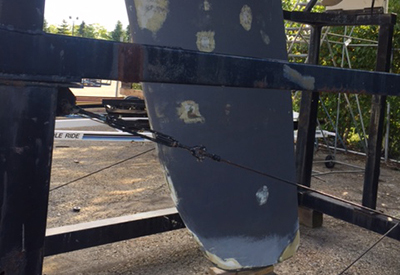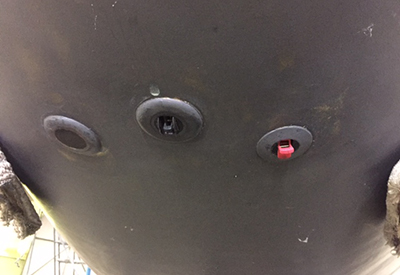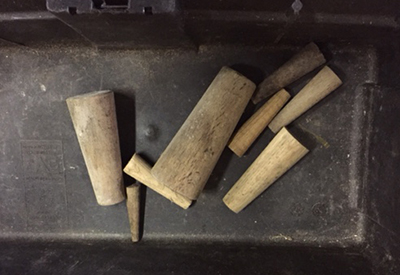Ask Andrew: I Hit Something! Now what? – Part 2

Sept 14, 2017
Repair underway on this damaged keel
The moment we all dread. It’s a warm sunny day and you’re out for a cruise. Suddenly the boat shudders beneath you, pings, dings and clangs are heard and you realize that you’ve hit something submerged.
Last month’s article began with the essentials: using good seamanship to get your vessel and crew to a position of safety – first and foremost.
I also tried to highlight the importance of speaking with your insurance company –
They may direct you to have certain work performed in certain ways (and your coverage may be dependent on following their instructions).
When looking at the vessel’s hull (out of the water), there are a few areas that should be reviewed when the hull or keel has suffered damage:
1) Keel – most modern sailboats have a keel bolted to the molded fiberglass hull. When an impact or grounding occurs, the keel should be checked for impact or scraping damage, and so should the joint where the keel meets with the boat’s hull.
2) Keel Bolts – these are heavy duty bolts that run upward from the keel into the boat’s hull, secured with a large nut. The nut, and top of the bolt are accessed through the floorboards from inside the boat. These should be checked for wear and to make sure that they remain secure. If the keel has flexed during an accident, the keel bolts may be affected, too.
3) Sterndrives and outboards – we often forget that the powerboat’s hull isn’t the lowest part moving through the water – the drive leg is sometimes a foot or more below the level of the hull – meaning that this is the part that will catch or ground first.
Be ready to trim drives up when entering shallow areas. It’s important to keep in mind that even with a depth sounder, the depth being read is the depth from the boat’s hull (wherever the depth transducer is installed), down – this measurement doesn’t include the drive leg!
4) Dagger boards, Drop keels and Centreboards – these are extensions of the keel – hinged, and stored inside of the keel when not in use and ‘dropped’ out of the hollow keel to be used in heavy seas or high winds. If the keel has been impacted, the hinge, pin or dropping/raising mechanism may also be damaged.  Underwater transducers measuring speed and depth
Underwater transducers measuring speed and depth
5) Through-hulls – any area where water is designed to enter or exit the hull (for engine cooling, scupper drains, bilge pumping arrangements, fresh water intake, air conditioning, etc). Any damage near or on a through hull could compromise it, allowing water to enter the boat.
 A selection of bungs to be used to stop leaks in broken hoses or leaking through-hulls
A selection of bungs to be used to stop leaks in broken hoses or leaking through-hulls
The most common emergency measure used when through-hull damage has occurred (particularly below the water line) is the use of a bung – a wood or rubber cone, designed to be wedged or hammered into the hole where water is pouring in. Many boaters keep a set of different sizes of bungs with their emergency supplies. I like to keep a second set, tied to each through-hull so that the correct size is readily accessible in an emergency.
The natural next question to consider when you hit something is ‘are we taking on water?’ If so, you need to be confident your bilge pump is in good shape. Next column, we’ll head into the bilge to consider the function and maintenance of this critical piece of equipment.
Safe boating everyone!
Andrew McDonald
 Andrew McDonald is the owner of Lakeside Marine Services – a boat repair/maintenance firm based in Toronto. Andrew has worked in the marine industry for 12 years and is a graduate of the Georgian College ‘Mechanical Techniques – Marine Engine Mechanic’ program.
Andrew McDonald is the owner of Lakeside Marine Services – a boat repair/maintenance firm based in Toronto. Andrew has worked in the marine industry for 12 years and is a graduate of the Georgian College ‘Mechanical Techniques – Marine Engine Mechanic’ program.
Questions or comments for Andrew? Email him directly via: askandrew@lakesidemarineservices.ca




























